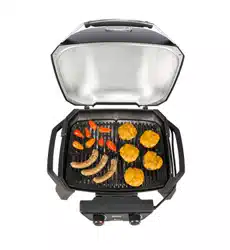Loading ...
Loading ...
Loading ...

12
EC Declaration of Conformity
Brand Name: WEBER
Model Name: PULSE 1000, PULSE 1000 w/Stand, PULSE 2000, PULSE 2000 w/Cart
(The model number sux has been clarified to indicate that the model number may
be followed by ‘XYZ’, with ‘X’ denoting the product’s colour or the accessories that
have been provided with the product, ‘Y’ also denoting the product’s colour or the
accessories that have been provided with the product and ‘Z’ denoting the region of
sale.)
Model Number: 81010053, 81010069, 81010074, 81010093, 81010094, 82010053,
82010069, 82010074, 82010093, 84010053, 84010069, 84010093, 85010053,
85010069, 85010074, 82010094, 84010074, 84010094, 85010093, 85010094,
81010079, 82010079, 84010079, 85010079
Product Description: Outdoor Electric Barbecue with iGRILL 3.
We, company Weber-Stephen Products LLC, located at 1415 S Roselle Road, Palatine IL,
60067, USA, issue this declaration of conformity under our sole responsiblity.
Object of the Declaration: WEBER PULSE 1000 & PULSE 2000 barbecues, which
also contain a transmitter and one probe for the PULSE 1000 or two probes for the
PULSE2000
The object of the declaration described above is in conformity with the relevant Union
harmonization legislation:
PULSE 1000 & PULSE 2000 are manufactured in compliance with the:
LVD Directive:2014/35/EU
EMC Directive:2014/30/EU
Food Contact Directive:1935/2004/EC
Directive 2012/19/EU Waste Electrical and Electronic Equipment (WEEE)
Directive 2011/65/EU Restriction of Hazardous Substances in EEE (RoHS 2)
Regulation No 1907/2006 Registration, Evaluation, Authorisation and Restriction of
Chemicals (REACH)
Council of Europe Resolution CM/Res (2013)9 on Metals and Alloys Used in Food
Contact Materials and Articles
and the following:
Safety/Health:
EN 60335-2-78:2003 + A1:2008
EN 60335-1:2012 + A11:2014
EN 62233: 2008
EMC:
EN 55014-1:2006 + A1:2009 + A2:2011
EN 55014-2:1997 + A1:2001 + A2:2008
EN 61000-3-2: 2014
EN 61000-3-3: 2013
and also the following:
Directive 2014/53/EU Radio Equipment Directive (RED):
Safety/Health:
EN 60950-1:2006+A11:2009+A1:2010+A12:2011+A2:2013
EN 62479:2010
EMC:
EN 301 489-17 V2.2.1:2012-09
EN 301 489-1 V1.9.2:2011-09
EN 55014-1:2006+A1:2009+A2:2011
EN 55014-2:1997+A1:2001+A2:2008
Radio:
EN 300 328 V1.8.1:2012-06
Notified Body: Eurofins Product Service GmbH, Storkower Strasse 38c, D-15526
Reichenwalde b. Berlin, Germany; Phone: +49-33631-888 000;
EU Identification Number: 0681; applied the standards listed above corresponding to
RED, and issued the EU-type examination certificate.
The object of this declaration functions using software and a smart device-enabled App
to which the software connects.
The product carries the CE mark which was first axed in 2017 and is EC type-
examination certified by: Notified 02830, UL International Demko A/S, Borupvang 5A,
DK-2750 Balleruo, DENMARK
Manufacturer’s Address:
Factory Name: Weber-Stephen Products LLC.
Factory address: 1415 S. Roselle Road, Palatine IL, 60067, USA
We, Weber-Stephen Products LLC 1415 S. Roselle Road, Palatine IL, 60067, USA, hereby
confirm that the following addresses are our branch addresses:
Weber-Stephen Deutschland GmbH, Rheinstrasse 194, DE-55218 Ingelheim, Germany
The establishment of quality assurance system is, UL International Demko A/S,
Borupvang 5A, DK-2750 Balleruo, DENMARK
Signed for and on behalf of Weber-Stephen Products LLC,
Palatine, IL USA on 10 July 2017
Ralph N. Ten Bruin
Global Director of Regulatory Aairs
Tips and Hints
REGISTRATION IS IMPORTANT
BarbecuingDo’s andDon’ts
Preheat barbecue each and every time.
If the cooking grates are not hot enough, the food will stick and you will
likely never have a chance of searing your food properly or developing those
handsome sear marks. Even if a recipe calls for medium or low heat, always
preheat the barbecue on highest setting first.
Don’t barbecue on dirty grates.
Placing food onto the cooking grates before they have been cleaned is never
a good idea. Left over residue on the grates acts like glue, binding it to the
grates and to your food. To avoid tasting last night’s dinner on today’s lunch,
make sure that you are barbecuing on a clean cooking grate. Once the grates
are preheated, use a stainless steel bristle barbecue brush to make a clean,
smooth surface.
Be present in the process.
Before starting your barbecue, make sure that everything you need is within
arm’s reach. Don’t forget your essential barbecuing tools, such as oiled and
seasoned food, glazes or sauces and clean cooking platters for the cooked
food. Having to run back to your kitchen not only means missing out on the
fun, but it could also result in burning your food. French chefs call this ‘mise
en place’ (meaning, ‘put in place’). We call it ‘being present’.
Create a little elbow room.
Packing too much food onto the cooking grates restricts your flexibility. Leave
at least one-quarter of the cooking grates clear with plenty of space between
each food item in order to get your tongs in there and easily move the food
around. Sometimes barbecuing involves split-second decisions and the need
to move food from one area of the barbecue to another. So give yourself
enough room to barbecue.
Try not to peek.
The lid on your barbecue is for more than just keeping the rain out. Most
importantly, it’s for preventing too much air from getting in and too much
heat and smoke from getting out. When the lid is closed, the cooking grates
are hotter, the cooking times are faster and the smoky tastes are stronger.
Usethe iGRILL App to quickly monitor the heat of your barbecue and the core
temperatures of your food so that you don’t need to open the barbecue until
it’s time for dinner. So put a lid on your barbecue!
Only flip once.
What’s better than a juicy steak with a deep sear and plenty of beautifully-
caramelised bits? The key to accomplishing these results is to keep your food
in place. Sometimes we have the tendency to flip our food before it reaches
the desired level of colour and flavour. In nearly all cases, you should turn
food just once. If you are moving it more than that, you are probably also
opening the lid too often which causes its own set of problems. So step back
and trust the barbecue.
Loading ...
Loading ...
Loading ...
